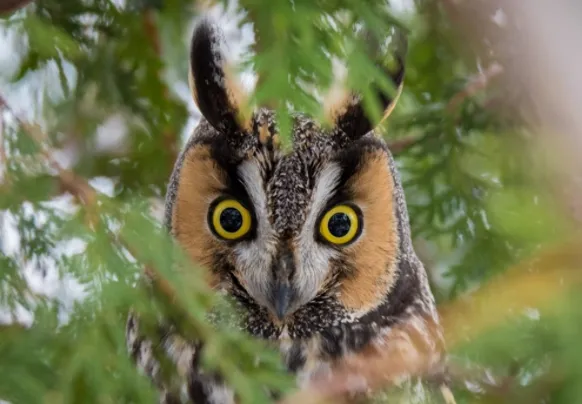The data was acquired only from reputable sources and double-checked with an ornithologist.
There are many different types of owls that can be found in Colorado. In this blog post, we will discuss the most common ones. The Great Horned Owl is the largest owl in Colorado, and it is also one of the most common. These owls can be identified by their brown coloring and large white patches on their wings. They prey on a variety of animals, including rabbits, skunks, and rodents.
Most Common Owls in Colorado
Western Screech Owl
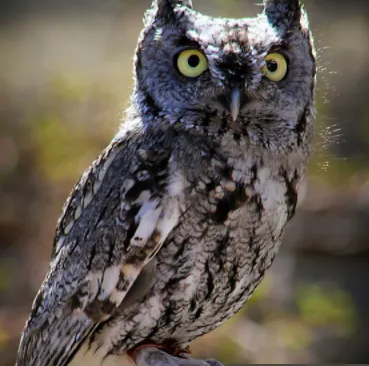
The Western Screech Owl is a small owl with a large, round head and no ear tufts. It has bright yellow eyes and a white facial disk with black around the edges. The upper parts of the bird are gray-brown with streaks while the underparts are pale with heavy brown streaks.
There is some variation in plumage among individuals, but all birds have a barred tail. The Western Screech Owl measures about 20 cm in length and has a wingspan of approximately 50 cm.
This owl is found in open woodlands, farmlands, parks, and urban areas throughout western North America. It is most active at night when it can be seen perching on fence posts or low branches in search of prey. The Western Screech Owl feeds primarily on small mammals such as mice and voles but will also take birds, reptiles, and insects.
If you live in an area where the Western Screech Owl is found, you may be lucky enough to see one of these fascinating birds up close. Keep your eyes peeled for these identifying characteristics and you’re sure to spot a Western Screech Owl sooner or later!
The best time to see a screech owl is during the day. Though they are nocturnal, they will sometimes call or even perch in daylight. Common vocalizations include a long trill lasting over a minute as well as shorter, more rapid trills and clucks.
To attract a mate, male owls will give a series of hoots that start low and increase in pitch before ending abruptly.

Great Horned Owl
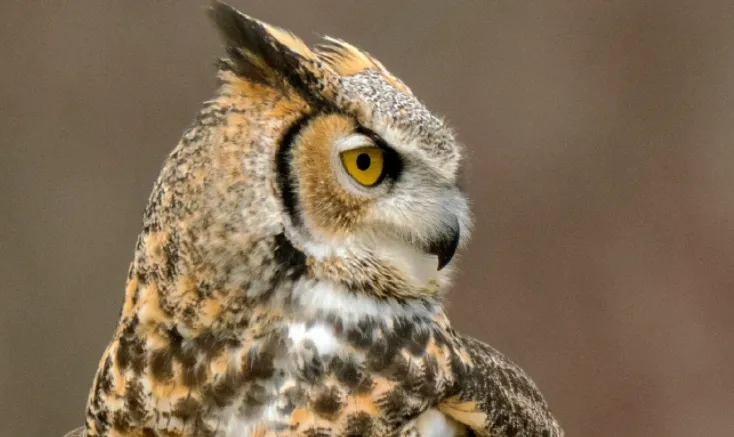
The Great Horned Owl is a large and powerful bird of prey. They are one of the most widespread owl species in North America, and can be found in nearly every type of habitat.
Great Horned Owls are easily identified by their large size, prominent ear tufts, and dark plumage with white patches on the throat and belly.
Great Horned Owls are proficient hunters and will take a wide variety of prey, including small mammals, reptiles, birds, and even fish. They are most active at night, but can also be seen hunting during the day.
Great Horned Owls typically nest in tree cavities or on cliff ledges, and will often reuse the same nest year after year.
Great Horned Owls are a common sight in Colorado, and can be found in both urban and rural areas.

Flammulated Owl
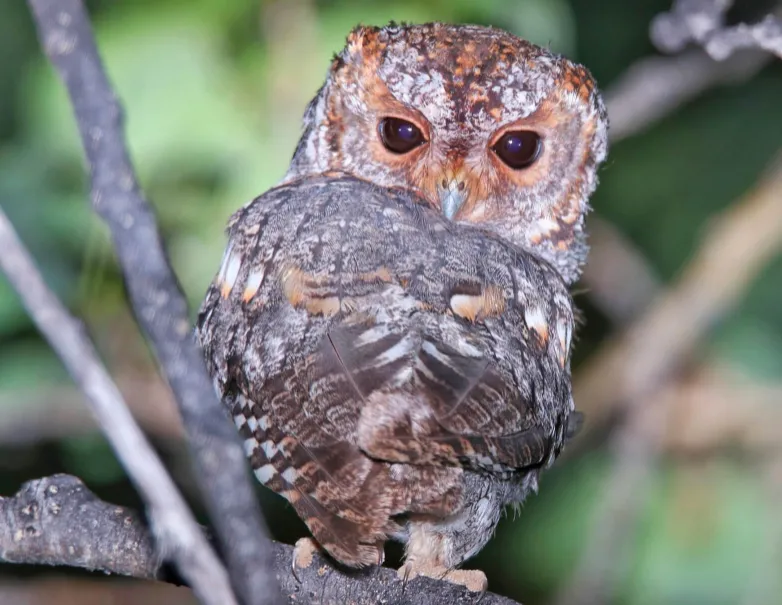
The Flammulated Owl is a small owl with large eyes. They are brown and white in color with grayish-brown bars on the chest. The facial disc is also grayish-brown with white around the eyes.
These owls are found in coniferous forests in the western United States and southern Canada. In Colorado, they are most often found in the foothills and mountains.
Flammulated Owls are nocturnal birds and very seldom seen during the day. They hunt for insects, such as moths and beetles, using their excellent hearing to locate them.
These owls roost during the day in cavities in trees or on branches. They nest in tree cavities, often using old woodpecker holes.

Barn Owls
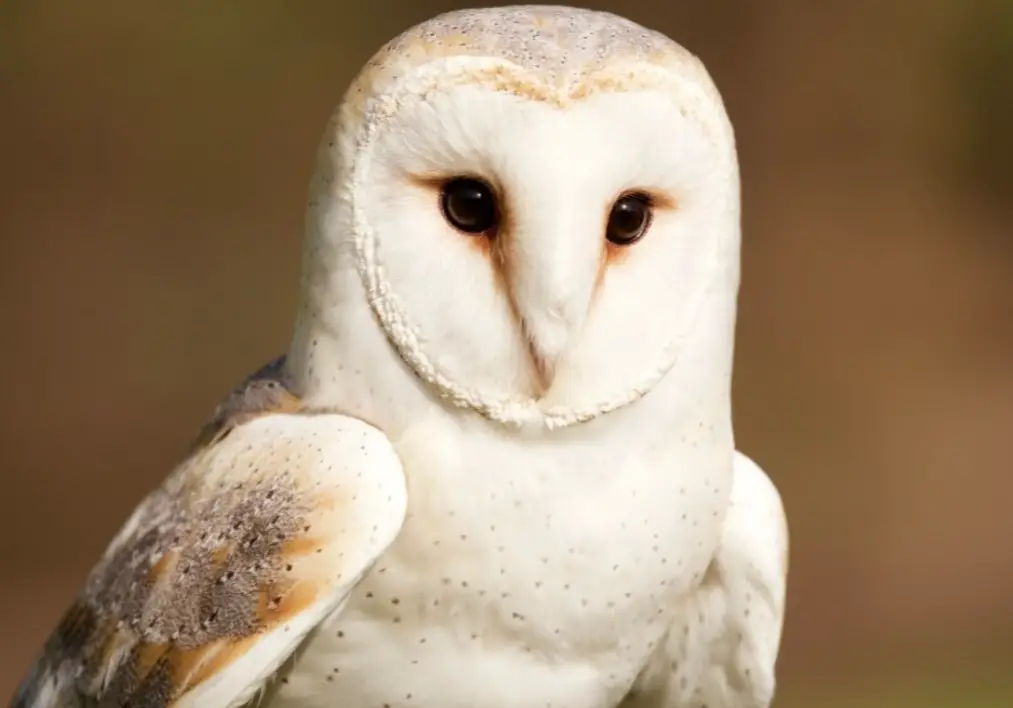
The Barn Owl is one of the most widespread of all owl species and can be found on every continent except Antarctica. In North America, they are most common in the western United States, but can also be found in parts of Canada and Mexico.
They get their name from their habit of roosting in old barns and other rural buildings.
Barn Owls are medium-sized owls, with a body length of about 13-15 inches. They have long legs and a short tail, which is pale in color and often has dark streaks. The wings are rounded and the feathers are soft and silky.
The head is large and heart-shaped, with a white face that is sometimes streaked with brown. The eyes are dark and the beak is black.
Behaviorally, Barn Owls are nocturnal hunters. They use their sharp vision and hearing to locate prey, which they then capture with their talons.
Barn Owls will eat a variety of small animals, including rodents, reptiles, and birds. In North America, their main prey is the vole.

Related post: Types of Owls in Alabama
Boreal Owl
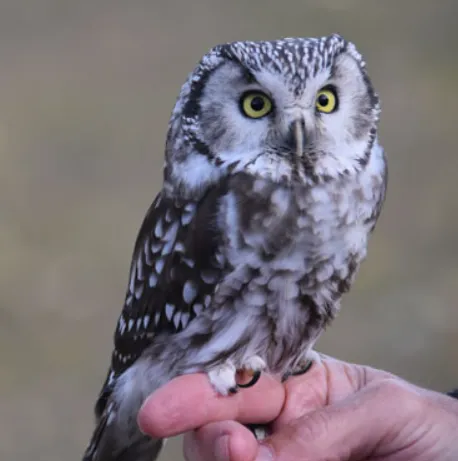
The Boreal Owl is a medium-sized owl with a round head and no ear tufts. It has large, dark eyes and a yellow beak. Its body is brown with white spots.
The Boreal Owl can be found in forests near the northern edge of North America. In Colorado, it is most commonly found in the mountains.
The Boreal Owl is a nocturnal bird, so it is most active at night. During the day, it roosts in trees. It hunts small animals, such as rodents and birds.
The Boreal Owl swoops down on its prey from a perch in a tree. It sometimes eats its prey whole, bones and all.
The Boreal Owl is a shy bird that is not often seen by people. If you are lucky enough to see one, you can listen for its call. The Boreal Owl makes a hooting sound that is different from other owls in North America. It also makes a “twit-twoo” sound. You can hear this sound in the video below.

Long-eared Owl
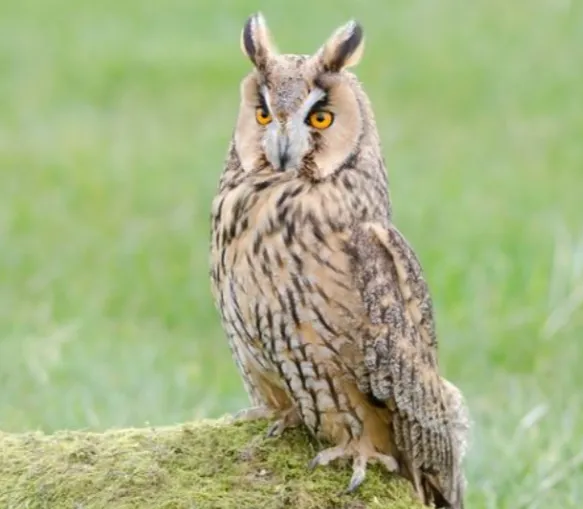
The long-eared owl is a medium-sized owl with prominent ear tufts. It has yellow eyes and a gray beak. The body is brown with white spots. The wings are brown with white stripes. The tail is brown with white bands.
The long-eared owl is found in woodlands, forests, and grasslands. It hunts at night for small mammals, birds, and insects.
The long-eared owl is a migratory bird. It breeds in the northern hemisphere from Alaska to Newfoundland. In the winter, it moves south to the United States, Mexico, and Central America.
The long-eared owl is active at night. It roosts during the day in trees, bushes, and thickets. The long-eared owl is a solitary bird. It does not form flocks.
The long-eared owl is shy and secretive. It is seldom seen. When it is disturbed, it flies away silently.

Short-eared Owls
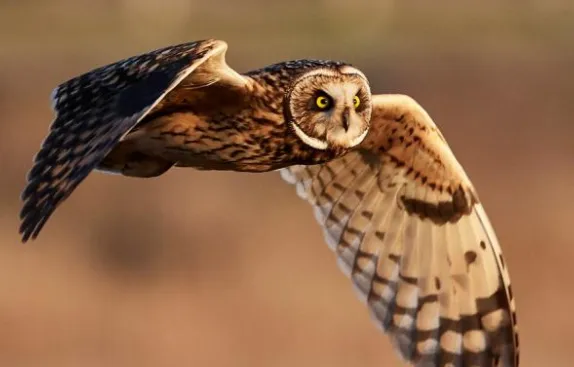
Short-eared Owls are relatively small owls, with males measuring 13-15 inches and females 15-17 inches in length. The wingspan of both sexes is between 31 and 37 inches. These owls are brown above with pale streaks on their back and wings, and they are white or buff below with dark streaks.
They have a round head with no ear tufts, and their yellow eyes are set in a black facial disk. Their call is a series of three to five hoots, which sound like “hoohoohoo.”
Short-eared Owls hunt primarily during the day, although they will also hunt at night. They prefer open habitats such as fields, meadows, and marshes. When hunting, they often perch on a high vantage point from which they can scan the ground for prey.
They will also sometimes hunt by flying low over the ground, using their keen eyesight to spot small mammals such as voles, mice, and rabbits. Once they have spotted their prey, they will swoop down and capture it with their talons.
Short-eared Owls typically nest on the ground, although they will also use an abandoned nest of another bird species if one is available.
The female owl will lay a clutch of four to eight eggs, which she will incubate for 28-33 days. The male owl brings food to the female while she is incubating the eggs, and he also helps to feed the owlets once they hatch.
The young owls fledge (develop their flight feathers) at about six weeks old, but they remain dependent on their parents for food for several more weeks.

Northern Pygmy Owl
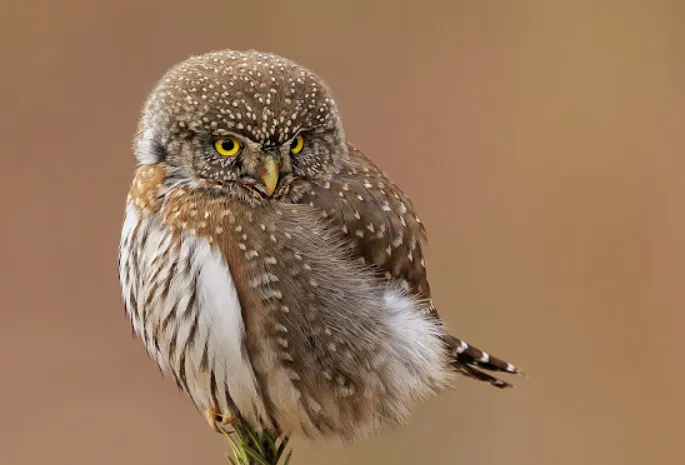
The Northern Pygmy Owl is a small owl measuring just over six inches in length. It has large, round eyes and a prominent ear tufts. The facial disk is white with blackish-brown streaks radiating from the center.
The upperparts are grayish-brown with heavy brown streaking. The underparts are whitish with heavy brown streaking. The bill is black and the legs and feet are gray.
This owl occurs in a variety of habitats including forests, woodlands, and even urban areas. It preys on small mammals such as mice and voles.
Northern Pygmy Owls are relatively sedentary birds and do not migrate. They are most active at dawn and dusk.

Burrowing Owls
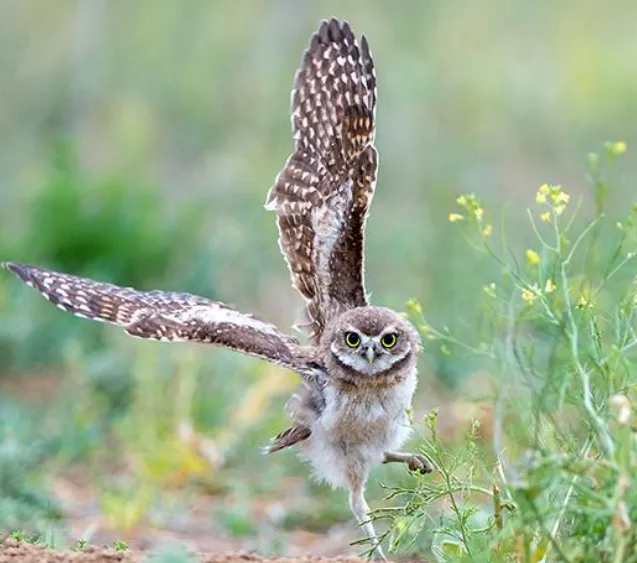
Burrowing owls are small, long-legged owls with large heads and no ear tufts. They have a white “eyebrow” above each yellow eye. The body is light brown with heavy white spotting. Wings and tail are barred with brown and white. Underparts are mostly whitish with some brown spotting.
These birds nest and roost in burrows, often taking over the abandoned tunnels of other animals such as prairie dogs. They may even use nest boxes. Outside of the breeding season, they roost singly or in pairs in burrows or on the ground under cover.
Although they are normally shy and avoid humans, Burrowing Owls have adapted well to living in open country with human activity, as long as there are suitable nesting and roosting sites available.
They hunt from perches or while hovering low over the ground, and will even chase prey on foot. Their diet consists of small mammals, reptiles, birds, and insects.
Burrowing owls are found in North and South America. In the United States, they are found in the western and southwestern states, as well as in Florida. They are found year-round in Colorado.

Snowy Owls
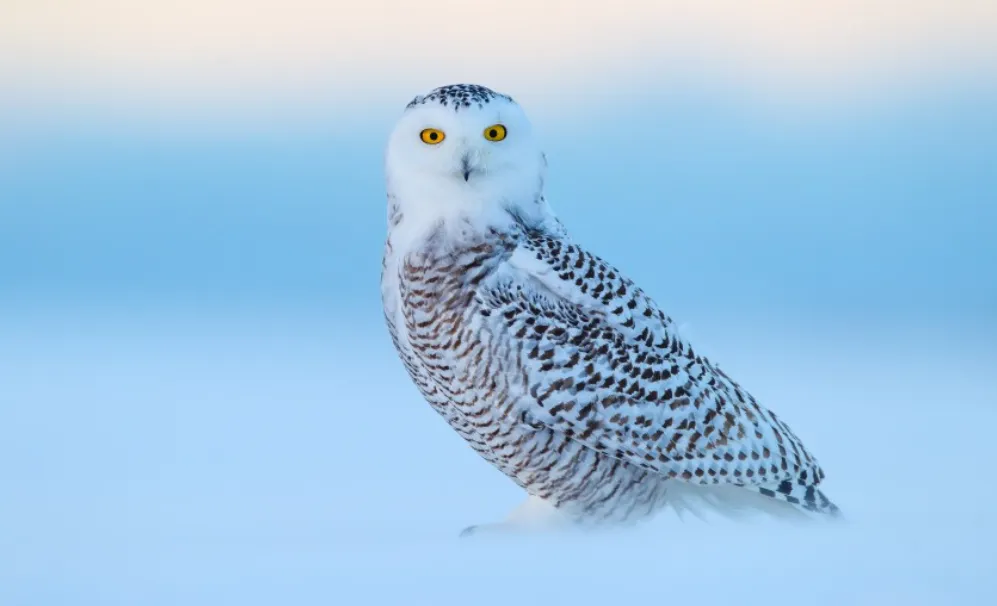
Snowy Owls are one of the most beautiful and intriguing birds in North America. These large, white owls with black markings are not only striking to look at, but they are also interesting creatures with some very unique behaviors.
If you’re lucky enough to spot a Snowy Owl in Colorado, here are some things to look for:
- The Snowy Owl is a large bird, with a wingspan of up to 60 inches.
- Adult Snowy Owls are almost entirely white, with some black bars or spots on the back and wings. Juvenile owls are more heavily streaked with black.
- Snowy Owls are most often seen in open areas like fields or tundra. In Colorado, they have been known to visit airports and open parks.
- These owls are predators and will hunt during the day or night. They eat a variety of small mammals, including rodents, rabbits, and lemmings.
- Snowy Owls are very curious birds, and will often approach people who they see. If you’re lucky enough to have one land nearby, enjoy the experience! Just be sure not to disturb the owl or its habitat.

Eastern Screech Owl
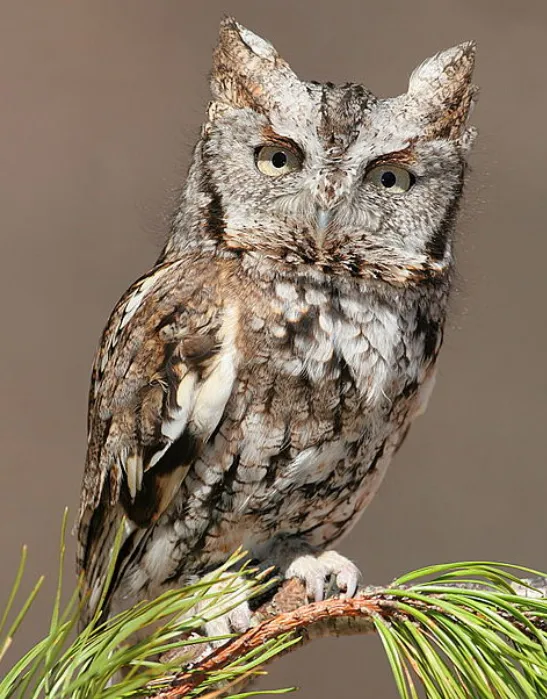
The Eastern Screech Owl is a small owl with a large head and big eyes. It has ear tufts, which are feathers that stick up on the sides of its head. Its back is gray or brown, and its belly is white with dark streaks. It has a short tail.
This owl lives in woods, forests, and parks. It nests in tree cavities. It eats insects, mice, and other small animals.
To find an Eastern Screech Owl, look for a small owl with ear tufts sticking up on the sides of its head. Its back is gray or brown, and its belly is white with dark streaks. It has a short tail. Look for this owl in woods, forests, and parks. It nests in tree cavities.
If you see an Eastern Screech Owl, you might hear it screeching or whistling. This owl is mostly active at night. During the day, it sits on a branch or perch and blends in with its surroundings.
When it is hunting, it quietly perches on a branch and watches for prey. Then it swoops down to catch its food. Eastern Screech Owls are good at catching mice and other small animals.

Northern Saw-whet Owl
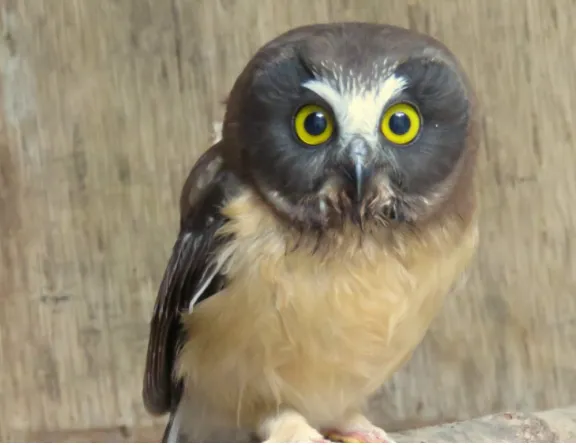
The Northern Saw-whet Owl is a small owl with a round head and no ear tufts. It has yellow eyes and a black beak.
The body is brown and white with dark streaks. The wings are short and rounded. The tail is long and square-ended. Northern Saw-whet Owls are found in woods, forests, and parks.
They hunt at night for mice, voles, and other small animals. In the winter, they sometimes eat birds. Northern Saw-whet Owls are found in North America.
In Colorado, Northern Saw-whet Owls are most likely to be found in the mountains. They prefer forested areas with dense vegetation. Look for them in areas with a mix of coniferous and deciduous trees, as they need both types of habitat to survive.
Northern Saw-whet Owls are nocturnal, so you’re most likely to see them at night. If you’re lucky enough to spot one, you’ll probably hear it before you see it. These owls make a loud, repetitive ‘toot’ sound that is easy to recognize.

Eastern Screech-Owl

The Eastern Screech-Owl is a small owl with large, round eyes. They are gray or reddish brown in color with streaks of white on their breast and belly. These owls have a whistling call that sounds like “kee-doo” or “knee-deep”.
Eastern Screech-Owls are found in wooded areas near rivers and streams. They nest in tree cavities and hunt for insects, small mammals, and reptiles.

What is the most common owl in Colorado?
The most common owl in Colorado is the Western Screech Owl.
Where can I see owls in Colorado?
The best place to see owls in Colorado is in the mountains. Northern Saw-whet Owls are most likely to be found in the mountains. They prefer forested areas with dense vegetation. Look for them in areas with a mix of coniferous and deciduous trees, as they need both types of habitat to survive.
Are owls good to have around your house?
Owls can be beneficial to have around your house as they help keep the rodent population under control. However, they can also be a nuisance as they are nocturnal creatures and their calls can be quite loud. If you’re considering having an owl as a pet, make sure to do your research first to see if it’s the right fit for you and your home.
What owls do we have in Colorado?
We have several different types of owls in Colorado, including the Western Screech Owl, the Northern Saw-whet Owl, and the Eastern Screech-Owl. Each type of owl is unique in appearance and behavior.

An avid ornithologist, zoologist and biologist with an unwavering passion for birds and wild animals.
Dr. Wilson’s journey in ornithology began in childhood and led him to obtain a Ph.D. in Ornithology from the prestigious Avian Research Institute. He has worked closely with renowned experts in the field and conducted extensive research and field studies globally.

